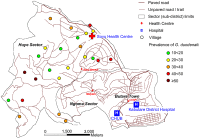High prevalence of Giardia duodenalis Assemblage B infection and association with underweight in Rwandan children
- PMID: 22720102
- PMCID: PMC3373622
- DOI: 10.1371/journal.pntd.0001677
High prevalence of Giardia duodenalis Assemblage B infection and association with underweight in Rwandan children
Abstract
Background: Giardia duodenalis is highly endemic in East Africa but its effects on child health, particularly of submicroscopic infections, i.e., those below the threshold of microscopy, and of genetic subgroups (assemblages), are not well understood. We aimed at addressing these questions and at examining epidemiological characteristics of G. duodenalis in southern highland Rwanda.
Methodology/principal findings: In 583 children <5 years of age from communities and health facilities, intestinal parasites were assessed by triplicate light microscopy and by PCR assays, and G. duodenalis assemblages were genotyped. Cluster effects of villages were taken into account in statistical analysis. The prevalence of G. duodenalis as detected by microscopy was 19.8% but 60.1% including PCR results. Prevalence differed with residence, increased with age, and was reduced by breastfeeding. In 492 community children without, with submicroscopic and with microscopic infection, underweight (weight-for-age z-score <-2 standard deviations) was observed in 19.7%, 22.1%, and 33.1%, respectively, and clinically assessed severe malnutrition in 4.5%, 9.5%, and 16.7%. Multivariate analysis identified microscopically detectable G. duodenalis infection as an independent predictor of underweight and clinically assessed severe malnutrition. Submicroscopic infection showed respective trends. Overall, G. duodenalis was not associated with gastrointestinal symptoms but assemblages A parasites (proportion, 13%) were increased among children with vomiting and abdominal pain.
Conclusions/significance: The prevalence of G. duodenalis in high-endemicity areas may be greatly underestimated by light microscopy, particularly when only single stool samples are analysed. Children with submicroscopic infections show limited overt manifestation, but constitute unrecognized reservoirs of transmission. The predominance of assemblage B in Rwanda may be involved in the seemingly unimposing manifestation of G. duodenalis infection. However, the association with impaired child growth points to its actual relevance. Longitudinal studies considering abundant submicroscopic infections are needed to clarify the actual contribution of G. duodenalis to morbidity in areas of high endemicity.
Conflict of interest statement
The authors have declared that no competing interests exist.
Figures
References
-
- Thompson RC, Smith A. Zoonotic enteric protozoa. Vet Parasitol. 2011;182:70– 78. - PubMed
-
- Pierce KK, Kirkpatrick BD. Update on human infections caused by intestinal protozoa. Curr Opin Gastroenterol. 2009;25:12– 17. - PubMed
-
- Berkman DS, Lescano AG, Gilman RH, Lopez SL, Black MM. Effects of stunting, diarrhoeal disease, and parasitic infection during infancy on cognition in late childhood: a follow-up study. Lancet. 2002;359:564– 571. - PubMed
Publication types
MeSH terms
LinkOut - more resources
Full Text Sources
Medical


